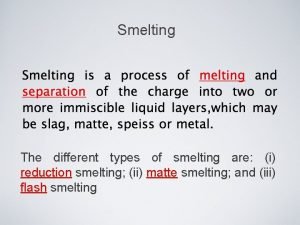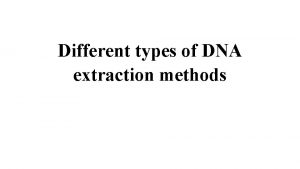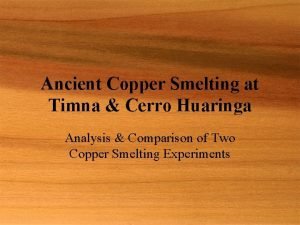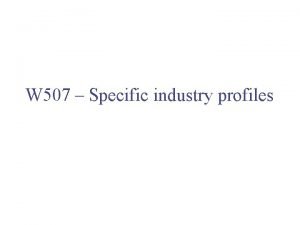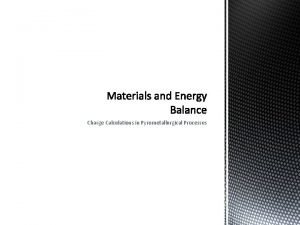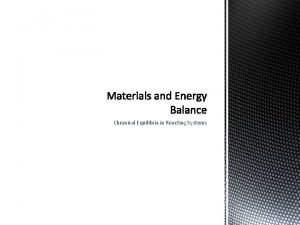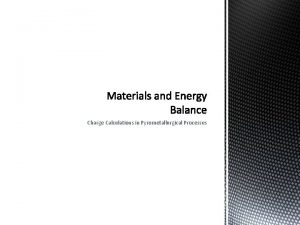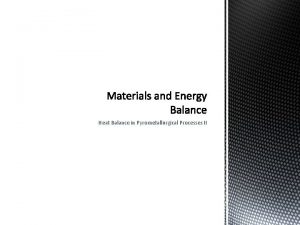Smelting The different types of smelting are i













- Slides: 13

Smelting The different types of smelting are: (i) reduction smelting; (ii) matte smelting; and (iii) flash smelting

The reduction smelting process involves the reduction of oxidic sources of metals with carbon in the presence of a flux mineral + reducing agent + flux = metal + slag + gases Example : blast furnace smelting of iron

The matte smelting process involves the fusion of sulfidic sources of metals with a flux without the use of any reducing agent sulfidic source concentrate + flux = matte + slag + gases speiss : a mixture of molten arsenides and antimonides of heavy metals Example : smelting of Cu or Ni ores

The flash smelting process combines into one the flash roasting and the smelting operations The sulfide concentrate fines react with oxygen at high temperatures. The oxidation process itself generates sufficient heat for the smelting process to occur simultaneously.

Furnaces used in smelting process: reverberatory, direct electric arc, circular blast, flash smelter, rectangular, etc. Reverberatory furnace

Furnaces used in smelting process: reverberatory, direct electric arc, circular blast, flash smelter, rectangular, etc. Flash smelter furnace (Inco technology)

Furnaces used in smelting process: reverberatory, direct electric arc, circular blast, flash smelter, rectangular, etc. Fluid furnace (Outokumpu technology)

Notes: 1. In smelting choice of slag composition to give the optimum balance of basicity and fluidity is important : maximum removal of impurities. 2. Matte smelting can be conducted at lower melting point than metal oxide smelting. 3. Matte smelting is normally carried out in a reverbatory furnace; electric arc furnace for higher temp. (1500°C); flash smelting: modern, improved, incorporating flash roasting with smelting

Example: Matte smelting of Cu 2 S - Fe. S 1. stage (removal of Fe. S) → 1350 o. C 2 Fe. S + 3 O 2 → 3 Fe. S + 5 O 2 2 Cu 2 S + O 2 2 Fe. O + Si. O 2 Cu 2 O + Fe. S 3 Fe 3 O 4 + Fe. S Cu 2 O + Cu 2 S 2 Fe. O + 2 SO 2 → Fe 3 O 4 + 3 SO 2 2 Cu 2 S → Cu 2 O + SO 2 → 2 Fe. O. Si. O 2 fayallite → Cu 2 S + Fe. O → 10 Fe. O + SO 2 → Cu + SO 2 2. stage (removal of S) → raw Cu (blistr): Ag, Au, Pt-kovy, Se, Te, Pb, Zn, Ni, As, Sb, Ni, Co, O 2 1150 o. C 2 Cu 2 S + O 2 → Cu 2 O + SO 2 Cu 2 O + Cu 2 S → Cu + SO 2

Reduction 1. Me. O(s) + C(s) 2. Me. O(s) + CO(g) ↔ Me(s) + CO 2(g) ↔Me(s) + CO(g)


O 2 grid e p lo s i R s g in CO 2/CO grid

 Insidan region jh
Insidan region jh Types of smelting
Types of smelting St helen’s smelting co v tipping (1865)
St helen’s smelting co v tipping (1865) Why do different polymers have different properties?
Why do different polymers have different properties? Why do different atoms produce different colors
Why do different atoms produce different colors Sound will travel at different speeds in different mediums.
Sound will travel at different speeds in different mediums. Sound travels fastest through
Sound travels fastest through Cultural relativism
Cultural relativism Different angle different story
Different angle different story Acid base song
Acid base song Manufactured boards examples
Manufactured boards examples What things make us special
What things make us special Venn diagram different same different
Venn diagram different same different Hát kết hợp bộ gõ cơ thể
Hát kết hợp bộ gõ cơ thể

